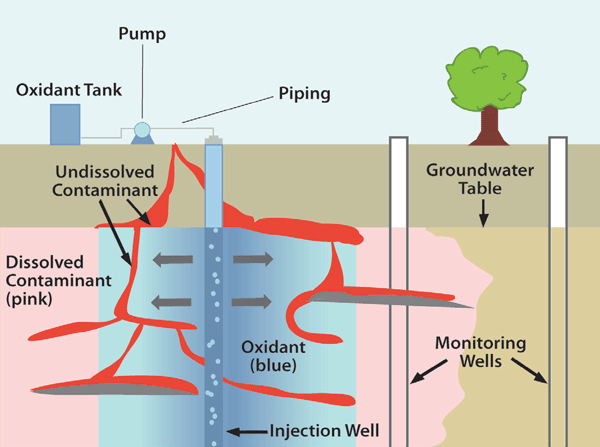
In Situ Chemical Oxidization Overview (ISCO)
In situ chemical oxidation (ISCO) involves the injection or direct mixing of reactive chemical oxidants into groundwater and soil for the primary purpose of rapid and complete contaminant destruction. ISCO is a versatile treatment technology that is most often deployed in source zones characterized by moderate to high contaminant concentrations in groundwater, significant sorbed contamination, and the potential presence of residual, separate-phase contamination.
Chemical oxidation uses chemicals called “oxidants” to help change harmful contaminants into less toxic ones. It is commonly described as “in situ” because it is conducted in place, without having to excavate soil or pump out groundwater for aboveground cleanup. In situ chemical oxidation, or “ISCO,” can be used to treat many types of contaminants like fuels, solvents, and pesticides. ISCO is usually used to treat soil and groundwater contamination in the source area where contaminants were originally released. The source area may contain contaminants that have not yet dissolved into groundwater. Following ISCO, other cleanup methods, such as pump and treat or monitored natural attenuation, are often used to clean up the smaller amounts of contaminants left behind. 
When oxidants are added to contaminated soil and groundwater, a chemical reaction occurs that destroys contaminants and produces harmless byproducts. To treat soil and groundwater in situ, the oxidants are typically injected underground by pumping them into wells. The wells are installed at different depths
Persulfate salts typically like Potassium persulfate is recommended for in situ oxidization, since potassium is necessary element required for Acerobic Remeidation which is followed by the oxidization treatment for a lot of is situ remediatioin project. and more potassium persulfate is easy to be transported and storaged comparing with liquid oxidizer Hydrogen Peroxide or the gas "Oxone".
In situ chemical oxidation (ISCO) is usually selected to clean up a source area, where it destroys the bulk of contaminants in situ without having to dig up soil or pump out groundwater for aboveground treatment. This can save time and money. ISCO has successfully cleaned up many contaminated sites and has been selected or is being used at around 40 Superfund sites and many other sites across the country.
Aerobic remediation is often introduced following the treatment of ISCO, as it long a relative last peroid for further cleanup of contamination of ground water and soil.
Details of In Situ Bioremetaion is available from http://www.biochemicals.cn/bioremediation.html
Our product being used in AEROBIC BIOREMEDIATION
Various remediation technologies add oxygen and/or an oxygen source such as hydrogen peroxide, or ozone to groundwater or soil. Various products have been developed to oxygenate groundwater and/or soil. the following decribes some of those products.
